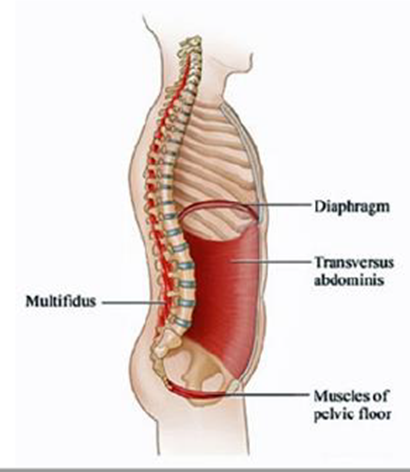
Most of the time when we hear the word “core” we think of our abdominals. And in fact it is important to keep the abdominals and all the other muscles of the trunk strong. These muscles work together to maintain good posture and to support and move the shoulders, the back and the hips. They are often referred to as the powerhouse of the body, stabilizing the trunk and allowing us to move our arms and legs powerfully and safely during exercise.
Beneath these core muscles are the muscles of the inner core and they have an important job to do. The brain is protected by the skull, the heart and lungs are protected by the rib cage, and the female reproductive organs are protected by the pelvic bone. But the remaining organs are protected by the inner core. The muscles of the inner core are the diaphragm at the top, the multifidus in the back, the transverse abdominis in the front, and the pelvic floor at the bottom. A weakness in the diaphram can lead to reflux. A weakness in the multifidus can lead to slipped discs, a weakness in the transverse abdominis can lead to a hernia. And a weakness in the pelvic floor can lead to incontinence.
Women are more likely than men to suffer from incontinence. However, in men sometimes an enlarged prostate exerts pressure on the urinary tract, controlling the flow of urine, and then the pelvic floor becomes weak. If the prostate is surgically removed, men will have a more serious issue with incontinence. Therefore, both men and women are encouraged to include pelvic floor exercises in their fitness routine. The Harvard Medical School recently published an article entitled “5 of the Best Exercises You Can Ever Do” which listed Kegel exercises as one of the five for both men and women. You can access the article at https://www.health.harvard.edu/staying-healthy/5-of-the-best-exercises-you-can-ever-do
Exercises to strengthen the pelvic floor are less often called Kegels because the research has changed the way the exercises are performed. To perform core contraction correctly, lift the pelvic floor and then gently draw in the transverse abdominis. There should be no change in your breathing. Incorrect core contraction involves strongly bracing the abdominals before lifting the pelvic floor, but this bracing puts downward pressure on the pelvic floor. Furthermore, you typically hold your breath during a strong brace of the core. Instead, keep your upper abdominals relaxed. Perform the exercise gently and slowly. Activate the pelvic floor smoothly. Draw in from the pubic bone. Use 30% effort when drawing in the transverse abdominis. Your breathing is gentle and continuous.
How long to hold the core contraction depends on the type of incontinence you are having a problem with (or wish to avoid). Stress incontinence is leaking when sneezing, coughing, etc. For this do 10 quick pelvic floor lifts 2 or 3 times a day. Urge incontinence is leaking on the way to the bathroom. For this do a maximum of 10 repetitions at a time, hold the contraction for 10 seconds at most, and take a 30 second break in between contractions.
My resource for this information is Marietta Mehanni, the pelvic floor ambassador in Australia, who presented a workshop entitled “Aquacise Your Pelvic Floor” for the Metroplex Association of Aquatic Professionals in Dallas on October 5, 2019. As you might guess, pelvic floor exercises can be done in a water fitness class.
See you in the pool!

Chris Alexander

Pingback: Activities of Daily Living – Water Fitness Lessons
Great delivery. Great arguments. Keep up the amazing spirit.
Please keep us up to date like this. Thanks for sharing…
After reading this awesome post I am delighted to share the link with
friends.
Greatt post! We will be linking to this great post on our website.
Keep up the great writing.
I got this site from my pal who shared the website link with me and now I am browsing
this site and reading very informative articles and reviews.
I do not even know how I ended up here, but I thought this post was
great. I don’t know who you are, but certainly you are going
to be a famous blogger if you are not already 🙂 Cheers!
This is the perfect blog for anybody who hopes to find out
about this topic. You definitely put a brand new spin on a topic which has
been discussed for decades. Wonderful stuff, just
excellent!
Nice blog here! Also your web site loads up very fast!
I wish my site loaded up as quickly as yours…
Very good post! We will be linking to this
great content on our website. Keep up the great writing!
I enjoy the clever work and reporting you guys are usually up to.
Keep up the very good work. I’ve added you to my own video.
Hello, after reading this amazing article I am happy to share this information with mates!
Very good post! We will be linking to this great content
on our website. Keep up the great writing!
Fabulous, what a web site it is! This web site provides useful data
to us, keep it up.
Hello all, this is a site where every person is sharing know-how, so it’s pleasant to read this website.
I plan to go to see this website daily.
Well composed articles like yours renews my faith in today’s writers. You’ve written information I can finally agree on and also use. Manny thanks for sharing.
Hello, I enjoy reading all of your articles.
I like to write a little comment to support you.
Great looking website. I assume you did a great deal of your very own coding.
I want to comment that you have a good website and I enjoy both the design and the articles!
Well composed articles like yours renews my faith in today’s writers. You’ve written information I can finally
agree on and also use. Many thanks for sharing.
Hello there! Would you mind if I share your blog with my twitter group?
There’s a lot of people that I think would
really appreciate your content. Please let me know.
Thanks!
Yes, you are welcome to share my blog with your twitter group. Thanks!
This is the perfect blog for anybody who hopes to
find out about this topic. You definitely put a brand new spin on a topic
which has been discussed for decades. Wonderful
stuff, just excellent!
Hey! This is my first comment here so I just wanted to give a quick shout out and say I truly enjoy reading through your articles.
Appreciate it!
Very good post! We will be linking to this great content on our website. Keep up the great writing!
I need to thank you for this fantastic read!! I definitely enjoyed every bit of it. I have got you
book-marked to look at new things you post…
Hello there! Would you mind if I share your blog with my twitter group?
There’s a lot of people that I think would really
appreciate your content. Please let me know. Thanks!
Reply: You are welcome to share my blog with your twitter group. Thanks!
After reading this awesome post I am delighted to share my experience here with friends.
Wow, amazing blog layout! How long have you been blogging for?
You make blogging look easy. The overall look of your web site is excellent, as
well as the content.
Reply: Thanks! I’ve been blogging for 5 years.
Greetings! Very helpful advice in this particular article!
It’s the little things that make the most important changes.
Many thanks for sharing!
Great post! We will be linking to this great post on our website.
Keep up the great writing.
Wow this is great work! Congrats and keep it up!
I do not even know how I ended up here, but I thought this
post was great. I don’t know who you are but certainly
you are going to a famous blogger if you are not already 🙂 Cheers!
After reading this awesome post I am delighted to share my experience here with
friends.
I like it whenever people come together and share thoughts. Great website, continue the good work!
Wow, amazing blog layout! How long have you been blogging for?
You make blogging look easy. The overall look
of your web site is excellent, as is the content.
Reply: Thanks, I’ve been blogging for 5 years.
Would love to perpetually get updated about this outstanding
web blog!
Reply: You can sign up for notifications by typing your email address in the sidebar to the right of the home page or at the bottom of a recent post and clicking “Follow.”